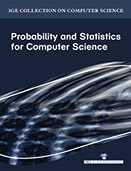
During the past 20 years, probability theory has become a critical element in the development of many areas in computer science. There are two different ways in which the computer is changing the field of statistics. First, computers can help us to do what we did before the advent of the computer but in a more efficient way. Second, computers can help us to do things nobody thought of before the advent of the computer. Another way to categorize the relation statistics-computer is to list the different ways the computer can be used in statistics. Work in computing increasingly relies on probability theory as a tool for analysis and data modeling. Furthermore, probability theory now plays a foundational role in making advances in many areas of computing. For example, while probability was once simply used as a tool to analyze the average running time of algorithms, it has now become a central tenant in developing a new class of randomized algorithms. In the area of Systems, probabilistic analyses of network routing and machine failures have become essential elements for building robust large-scale distributed systems, and will continue to become more important with the growth of "cloud computing". Much work in Artificial Intelligence is now based on probabilistic formalisms, encompassing work in reasoning, robotics, natural language understanding, and machine learning. Specifically, the widespread use of data mining techniques for analyzing large data sets involves algorithms grounded in probability theory.
This edition is packed with introductory topics in probability with this particular emphasis, providing computer science students with an invaluable resource in their continued studies and professional research. It provides a versatile and lucid treatment of classic as well as modern probability theory, while integrating them with core topics in statistical theory and also some key tools in machine learning. Special emphases on simulation and discrete decision theory are also presented. This book will also be of interest to practicing engineers and researchers in these areas.